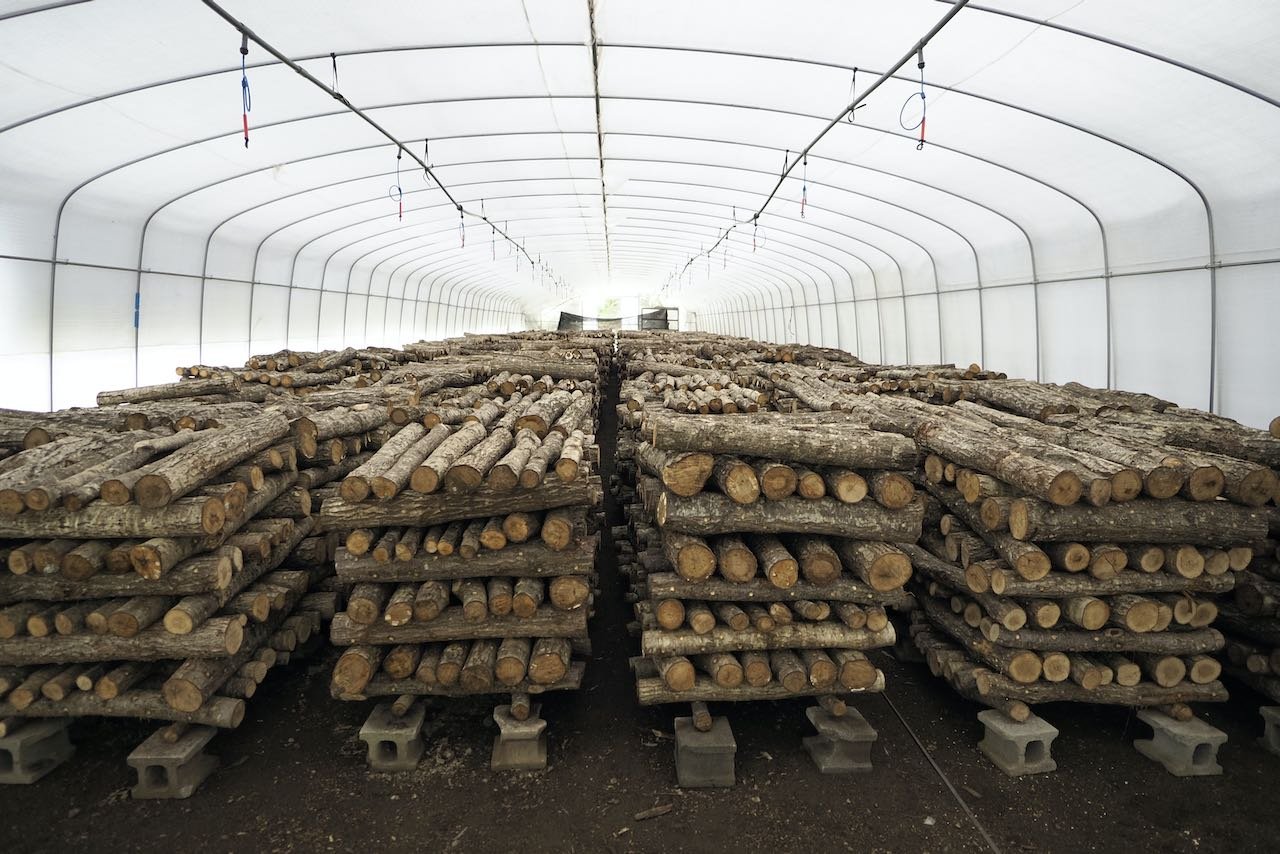The basics of forest-cultivated mushroom production systems
Figure 1. Shiitake “bolts” in a forest-cultivated production system in Japan. Most of the shiitakes that are grown under open forest canopy in this manner in Japan are intended for dried shiitake markets.
This is a system of production where the mushrooms are typically grown outdoors, under forest canopy, on logs. The logs serve as the substrate (food) for the mushrooms. Most production done in this manner occurs in Japan, China, and on a small-scale throughout eastern North America. This production system is mainly used to produce shiitake (Lentinula edodes), but may also be used for producing several other species of white-rot types of edible fungi. White rot fungi can generally be thought of as decomposers of lignin-rich carbon sources, most notably the wood of broadleaf trees. White rot fungi are “saprophytes”, meaning they consume organic carbon that is dead, rather than living. In Japan, other species of white rot-fungi that may be more commonly produced on logs are nameko mushrooms (Pholiota microspora), or hiratake (oyster mushrooms, Pleurotus species). In eastern North America, other species besides shiitake that may commonly be forest-cultivated are oyster, lion’s mane or “comb tooth” mushrooms (Hericium species), and wine cap mushrooms (Stropharia rugosoannulata).
The system that is used today is largely based on an innovation that was made to traditional production of shiitake on logs in Japan in the 1940s. This innovation used holes that were drilled in the log as inoculation points throughout the log’s sapwood, and small wooden dowels or sawdust inoculated with shiitake mycelium (termed “spawn”) were then used as the “seed” to inoculate the log by inserting the dowel or sawdust into the drilled hole(s) (See Figure 2). This system of producing mainly shiitake uses “bolts”, or 3-4’-long logs that are typically 4-6” in diameter.
Figure 2. Oyster mushrooms (Pleurotus species) being produced from a “totem” under forest canopy. Production of mushrooms using totems is largely limited to small scale-production in eastern North America.
In eastern North America, Pleurotus mushrooms and Hericeum mushrooms are more typically grown in a different type of system using “totems” (Figure 2). Totems are comprised of two sections of 1’-long larger-diameter logs (usually ≥10”) that are stacked perpendicular to the ground along with a smaller 2-3” section that is placed on top as a “cap”. The totem is inoculated by sandwiching a layer of Pleurotus or Hericeum sawdust spawn in between the log sections of the totem. Stropharia mushrooms do not use a log, but rather use wood chip beds that are typically mixed with Stropharia sawdust spawn and compost. In addition to stropharia mushrooms not using logs, they also can be grown in partial shade or even in full sun.
In the Pacific Northwest, to date, the most viable option for producing forest-cultivated mushrooms appears to be shiitake production systems using bolts. This is mainly because shiitake produces the most reliable and abundant yields, and because bolts can be managed in ways that better support the vitality of the fungus, and also allow for better quality control over the mushrooms. Mushrooms produced in totem systems or in wood-chip beds may yield variably and unpredictably, and are often attacked by pests and degraded by rain because totems and wood chip beds can not be easily protected from either factor while mushrooms are fruiting.
Hybrid systems of production also exist where mushrooms are still grown on logs, but are grown under cover in shaded structures such as high tunnels, hoophouses, or greenhouses (Figures 5 & 6 below). These types of hybrid production systems are frequently used in Japan when shiitake is being grown for fresh markets, as opposed to for dried shiitake markets. Growing mushrooms this way under cover allows for better quality control and some limited season extension. This type of production has not yet be evaluated in the PNW, but may have some promise for expanding the ways that shiitakes may be produced in the region.

Figure 3. Vigorous mycelial growth of shiitake fungus on log ends. Mushrooms produced in forest-cultivated systems are all "white-rot" fungal species, which are associated with decomposition of non-living wood of broadleaf trees.

Figure 4. A cross section of an oak log that has been inoculated with shiitake fungus through inserting "spawn" (pre-inoculated sawdust or small wooden dowels) into a drilled hole penetrating into the log's sapwood. The light-colored sections illustrate where the fungus has grown laterally through the log from the inoculation point through the vascular system of the log and begun to decompose the wood.

Figure 5. Crib stacks of shiitake bolts inside a hoophouse in Japan during the "spawn run" year. The spawn run is the time period between inoculation and the first harvest, while the fungus is colonizing the log. Spawn run is usually no less than 9 months but may be up to 2 years. In this hybrid system, the hoophouse is being used to try and hasten spawn run.

Figure 6. Shiitake bolts set up for harvest in an "A-frame" pattern in a hybrid indoor/outdoor system in Japan using shade structures rather than forest canopy. These hybrid systems are used partly to allow for some production season extension but also for added quality control. Shiitakes being produced for fresh market in Japan are often fruited in shaded indoor structures for this reason.

